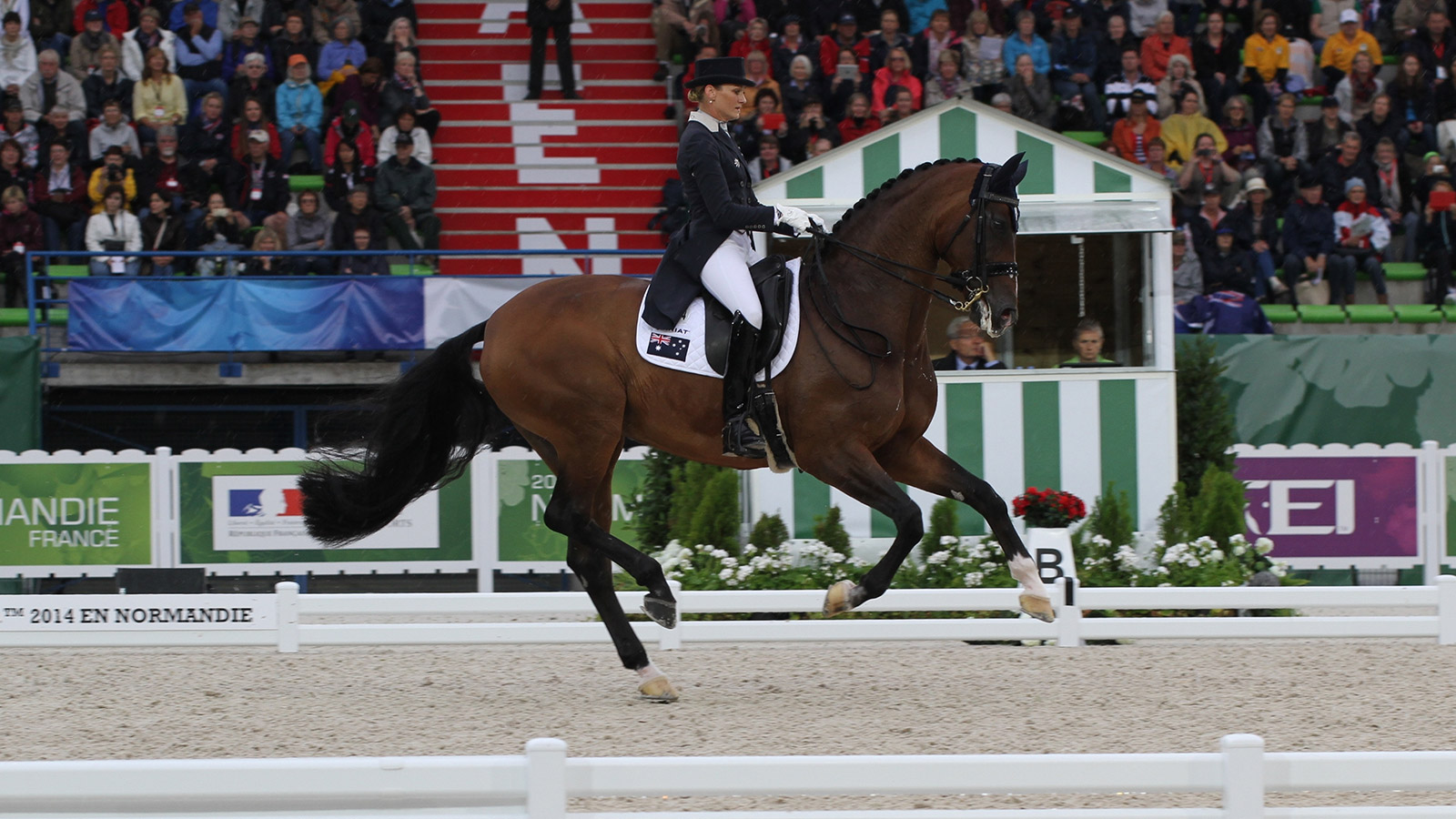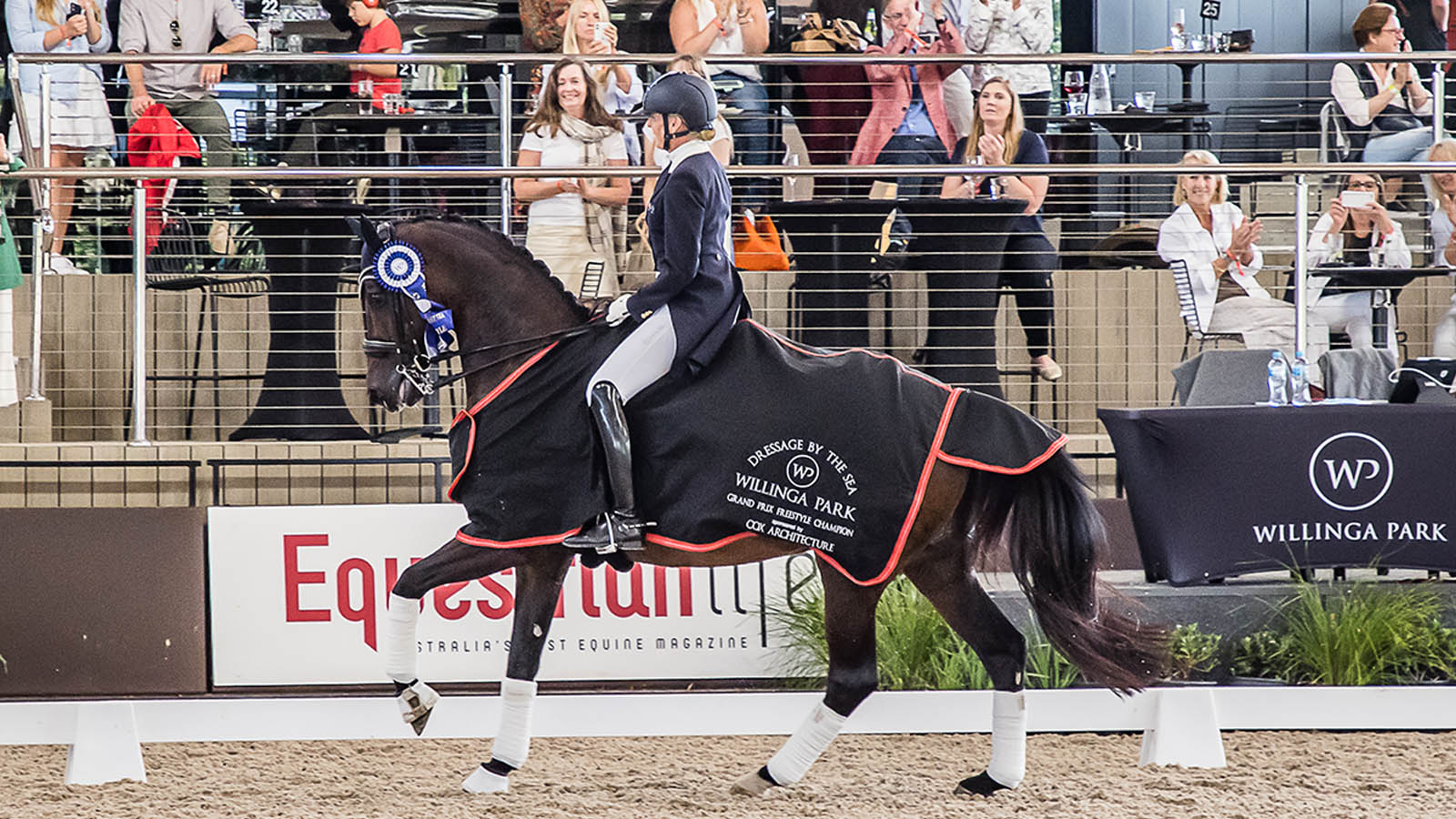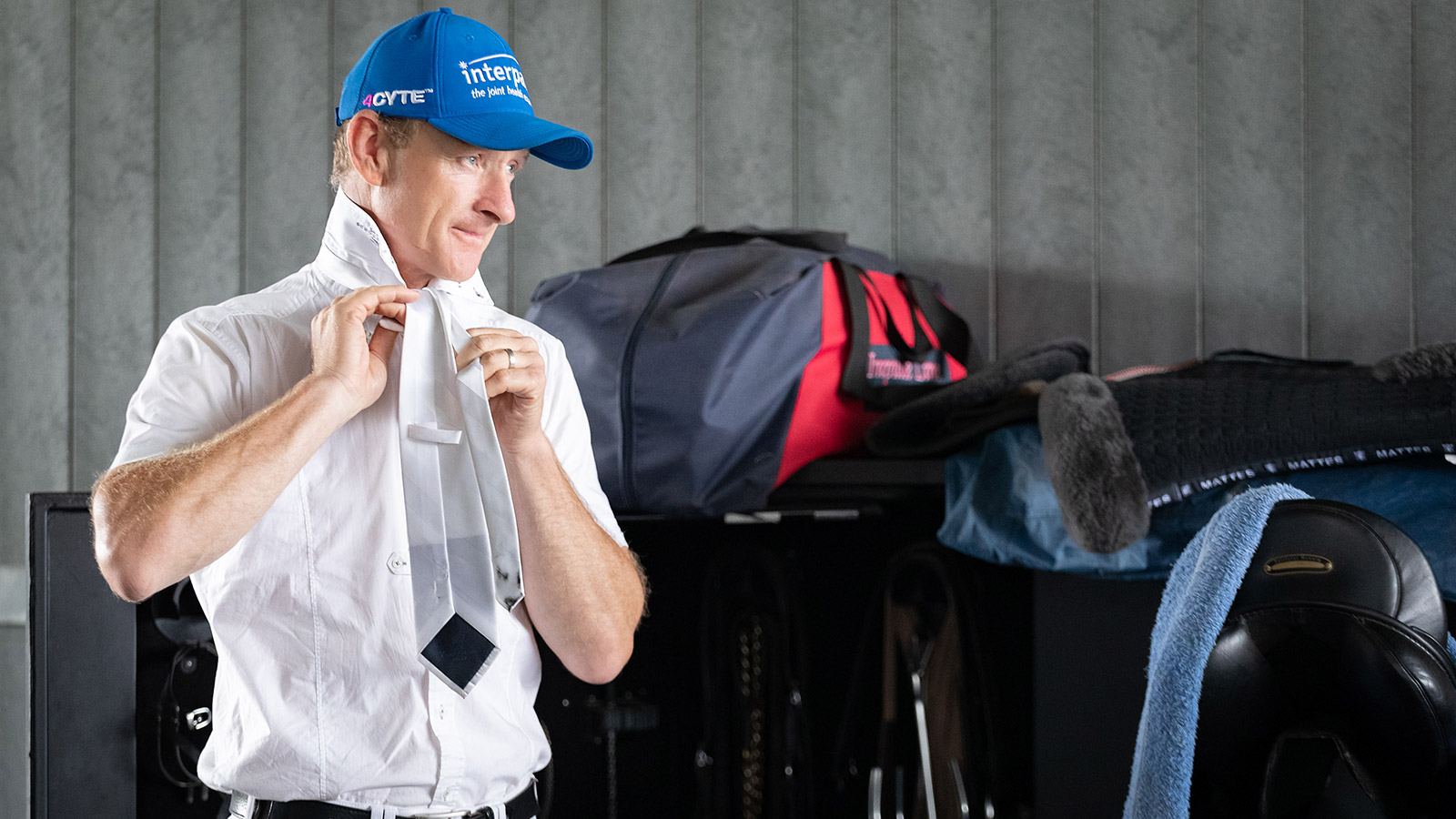When the outside world came to a standstill last year, so did the world of Australian dressage rider Maree Tomkinson. Despite personal loss and grief, Maree remains dedicated to her horses and the sport and is looking to the year ahead with her exciting team of up-and-coming horses.
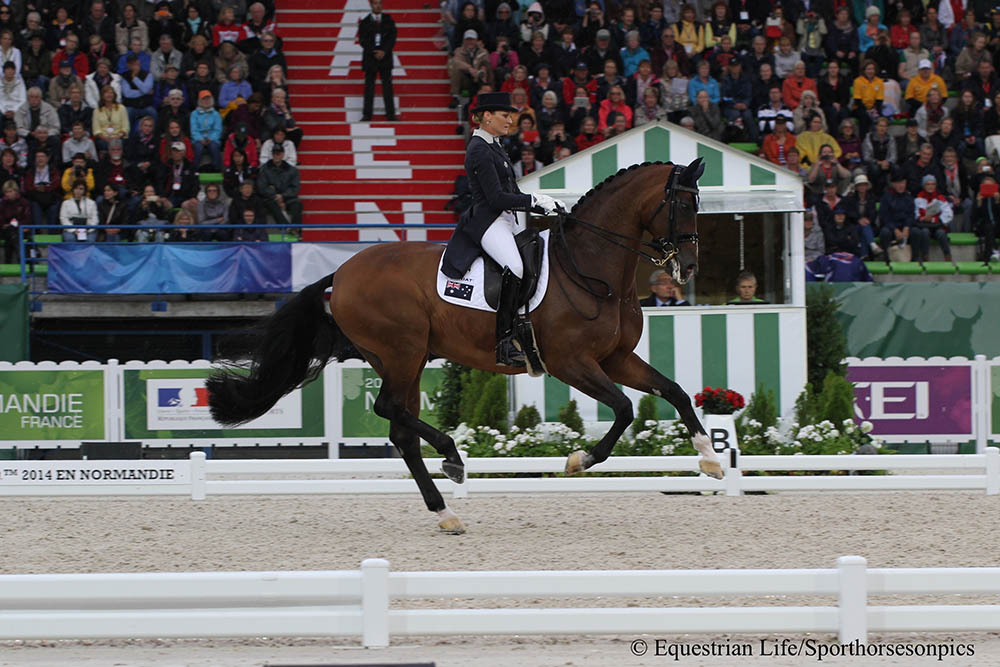
Maree Tomkinson and Diamantina competing in the World Equestrian Games in Normandy, France in 2014. © EQ Life/Sporthorsesonpics.
“My father was in hospital,
the dog was in hospital and
so was the horse.”
All within the space of a few months, Maree’s father become severely ill and passed away, one of her best horses, Grand Prix star Donna Elena, went through major surgery, and her beloved dog also succumbed to cancer.
Maree remembers these few months as utterly painful and draining but was grateful she had the time to devote to each member of her family – both human and animal – while the outside world battled the coronavirus. “In one way, Covid has been quite kind to me,” says Maree. “My father went into hospital and passed away in January.
“In December, my father was in hospital, the dog was in hospital and so was the horse. This was a really hard time. I got to spend the last few months of his life with him, as everything else had stopped. It was great to be able to spend that time with him… with them.”
And with Donna Elena out of action following an accident in the stable, it was just as well that the competition season had been wiped out by Covid-19. Maree says Donna Elena has always been a difficult horse to stable. “She’s a bad roller; she has been her whole life,” explains Maree. “We learned very early on that she gets cast easily. She’s the only horse in the barn that gets stable bandaged. It’s really hard. She broke her splint bone a couple of years ago doing the same thing, hitting her leg into the feed bin, so we’re always modifying things. She even ended up needing her splint bone removed.”
Despite Maree installing cameras in the stable to keep an eye on the mare, Donna Elena again cast herself in the stable just before Christmas last year. Maree was teaching English rider Hayley Gears in the arena, and Chris Pearce was also there at the time. Maree said prior to that she had been hand-grazing Donna Elena, “so I brought her in from the paddock and put her in the stable. I went into the arena, and 40 minutes later when I finished the lesson, I came out and she was upside down in the stable.
“She didn’t make any noise — she was just upside down. And the arena is on the other side of the wall of the stable, so I was literally right there. Luckily, Chris was there because he helped me roll her over. She got up and she was clearly in a lot of pain.
“He took her to the South Eastern Equine Hospital in Cranbourne, and she had surgery. She’s fine now. It’s three months post-surgery. She’s got another month to go and then I can start riding her again.” Maree is confident Donna Elena will be fine but is also realistic. “We’ll just see what we see. There are lots of horses that have colic surgery and go on and have very successful lives, so let’s hope that’s the case.”
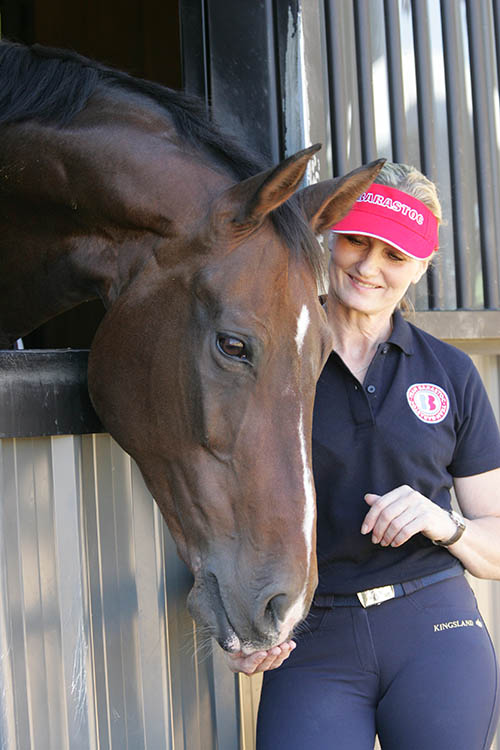
Barastoc’s excellent feeds play a vital role in ensuring Maree’s horses are competition-ready.
“If I could manage to ride her
half as well as Edward,
I’ll be happy!”
RISING STARS
With Donna Elena still in recovery, Maree has been focusing on some of the younger horses in her stable. One particularly exciting young mare is eight-year-old Total Diva, out of Maree’s famous mare Diamantina and by Edward Gal’s former world-beating partner, the late Totilas. “She’s got a lot of her mum’s character, but to me she looks more like her father.
“She’s a lot more like I would have imagined Totilas would have been. She’s a very determined, strong-willed horse. For me, I think she’s the best horse I’ve ever had. If I could manage to ride her half as well as Edward [who rode her sire], I’ll be happy!”
Maree has been slowly training Total Diva towards Grand Prix, but she says the mare’s strong will is certainly keeping her on her toes. That being said, she’s edging closer to a Big Tour debut. “She’s still struggling a bit with the one-time changes. We’re just holding off on a Grand Prix start until we get a better handle on the ones.”
Total Diva’s half-brother, a striking colt, is also growing up under Maree’s watchful eye. So far officially unnamed, his stable name, Voltage, is a little nod to both his energetic parents.
Maree says a large part of keeping her team in top condition is to do with their feed. “All of our horses are on Barastoc feeds. We use Calm Performer, Thurra, and of course Command, which has Diamantina on the bag. And we’re also interested in the new Supreme they’ve just released. Barastoc have a wonderful variety of really high-quality feeds that have got lots of different additives already built in, so we don’t have to add a whole lot which is great. All the horses like it.
“They’re always in beautiful condition; their coats are beautiful, they are fit, healthy horses and they are only as good as the fuel you are putting into them. We’ve been using Thurra for more than 20 years, and it’s just such a great feed. I am sure there are other horses in the world that look as well as my horses do, but no horses look better! We are incredibly lucky to have Barastoc behind us. They’ve been a great support and they have an excellent product. We are lucky and grateful on all fronts.”
A recent addition to the Tomkinson stable is a four-year-old imported warmblood mare called Imagine, co-owned by Maree with Susan and Victoria Gorst. “She’s super fancy, I think she’ll be very impressive,” says Maree. “Imagine has been home for a few weeks now, after being imported from Europe, and she seems to have a really lovely character and she certainly ticks a lot of boxes.
“She’s from Johannes Westendarp, which is where Diamantina came from and Donna Elena and Furst Deluxe. I have worked with Johannes with young horses for years now and I really trust him. He knows what I like to ride, and I’ve been very lucky so far not to have bought the wrong one. Every one that I’ve bought has been the right one so far, so this is very good.”
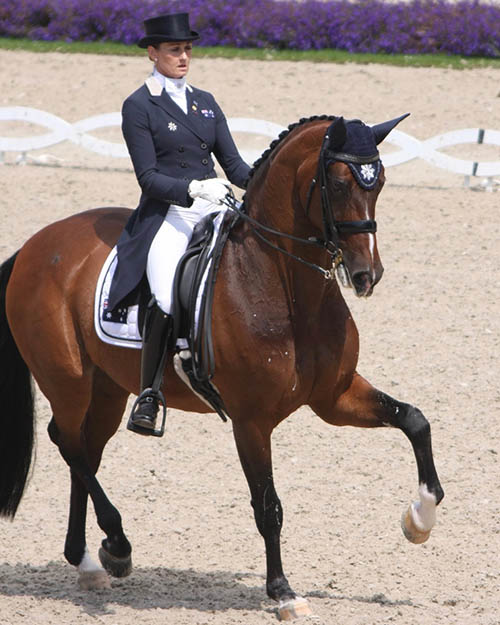
Diamantina’s expressive and sometimes fiery character has endeared her to a generation of dressage fans.
HRH DIAMANTINA
After her highly successful career in the dressage arena, Maree Tomkinson’s famous Oldenburg warmblood mare, Diamantina, has been enjoying her new-found and somewhat pampered retirement. Maree says she stopped riding Diamantina last year after she turned 18, but she has mostly kept to the same routine.
“She comes out of the stable and we free-lunge her. She’s extremely temperamental. She’ll go outside in the yard for two or three months, and then for some reason, she’ll decide she’s just not going in the yard anymore; she hates the yard and she’s never going outside again! Then she won’t go outside for a while because, otherwise, she’ll just run up and down like a crazy horse. And then after a while we’ll try again and she’ll go outside for a while; there’s no rhyme or reason to it.”
“I have tried everything. I’ve put her in with other horses and I’ve left her out there until she nearly killed herself running up and down the fence. Unfortunately, I’m just not prepared to leave her like that. It’s not until you can actually see what she’s like that you fully appreciate it. She’s her own person and she decides what she wants to do and we just all follow! So, if she needs to keep coming into the stable and being treated like she’s the queen of the place, then I’m completely prepared to do that.”
ROYAL BIOGRAPHY
With such a character, it is little wonder that Maree Tomkinson has plenty of stories about the warmblood mare. Maree has begun work on a book to share her journey with Diamantina from training her as a young horse all the way to the World Equestrian Games in France in 2014.
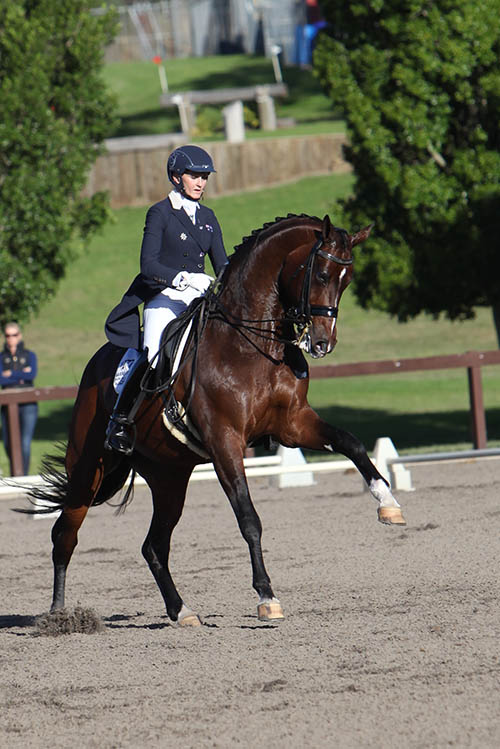
Maree Tomkinson hopes some of her up-and-coming young horses will be as successful as Diamantina.
“Diamantina holds a very special
place in my heart.”
“I think the story about Diamantina is really inspiring, and I think that it’s a good story and it will be really cathartic for me to write it,” says Maree. “It’s the space in your head that you need to find and experience the emotion. I understand why writing is such a go-and-escape-to-a-secluded-place experience because it’s hard to find the space in your head to write it. I’ve still only done my first paragraph — I’ll get there eventually.
“I hope it is interesting for people to read and maybe a little inspiring. We’ve come from such a long way and, nowadays in the sport, it is becoming rarer and rarer for people to actually train their own horses. We got her as a team of people who put in and bought a young horse, and she did incredibly well and made all our dreams come true.
“She was certainly the horse of a lifetime for us but it was hard. I think sport is now, in general, hard for a lot of people and there are probably a lot of stories similar to ours. But sometimes from the outside you think it is all sweetness and light but it’s not. It can be really hard to actually get there in the end. There were lots of challenges put up in front of us – not least Diamantina’s own character!”
A classic example of Diamantina behaving like a princess was when she refused to go through the tunnel to the arena for Maree at the WEG in France in 2014. The clock was counting down to when they would be eliminated, so Maree had to quickly dismount and lead her in, then remount just in time to ride the test. It was a dramatic delayed entrance, but they went on to ride the test of her life.
“Lone Jorgensen wrote me a message afterwards that said, ‘you wouldn’t expect it to be any other way’ and that’s a bit how it was. She was her own special character and she made me fight for it to the last minute. Diamantina holds a very special place in my heart. She opened a lot of doors and she certainly took me places that I had hoped but never actually believed that I could go.”
“She’s fat and shiny and very beautiful and lives in a stable close to my house just living her life. She lives life like a princess and doesn’t have to do any work!”
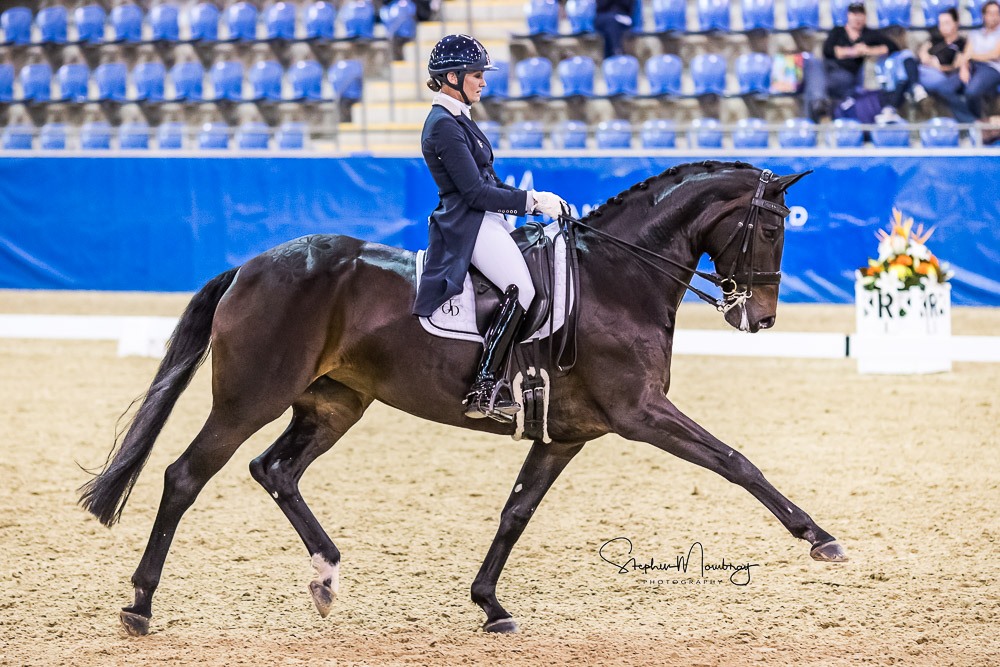
Maree Tomkinson and her beautiful Donna Elena. © Stephen Mowbray
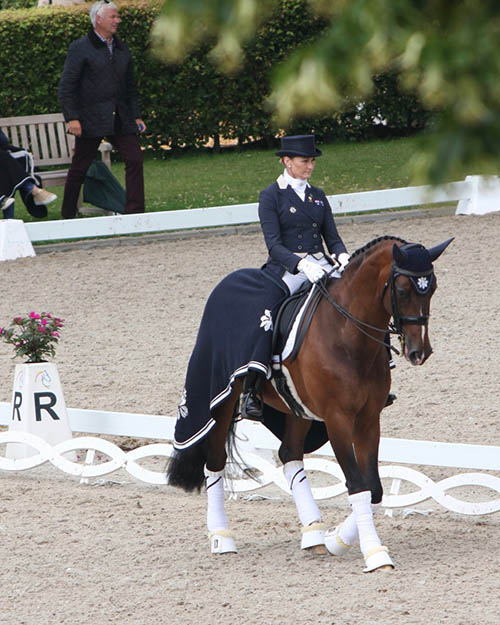
Immaculate as always, Diamantina has had a highly successful career with Maree.
“I am sure there are other horses
in the world that look as well as
my horses do, but no horses look better!”
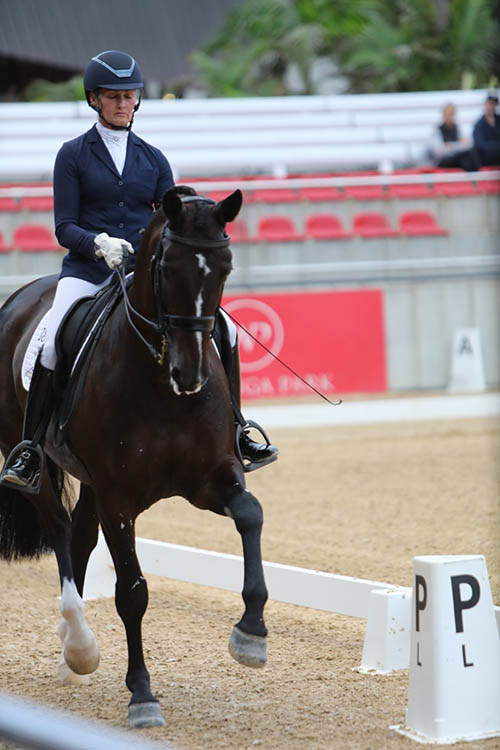
The future looks bright for Maree and Total Diva © Roger Fitzhardinge
BACK TO THE ARENA
With Covid restrictions easing, particularly in the eastern states, Maree is now looking ahead to the coming competition season after the emotional rollercoaster of the past few months. She has already been out on the dressage circuit competing at the Werribee Park Young Dressage Horse Competition, as well as judging at the Barastoc Horse of the Year Show.
“I am trying to put one foot in front of the other and get the horses out and qualified for the bigger events so that hopefully, later in the year when we are able to, I will feel like doing some more competitions,” says Maree. “I personally don’t believe you need to take your horses to a million competitions. I think this is really the best way… you are better off spending your time home training, and competing a bit, then go home and train some more and then compete a bit more.”
However, Australia’s borders closure, which has left events unable to source international judges for CDIs, has half-halted the upcoming dressage season. As the Riders’ Representative on the Equestrian Australia Dressage Committee, Maree says she hopes to see the upcoming major dressage season run as close to normal as possible.
“My opinion, for what it’s worth, is that we should run our big competitions, such as Dressage with the Stars, the Sydney CDI, the Boneo Classic, and Willinga, as close to a CDI as possible — even if we call it a CDI equivalent,” she says. “We should still run under FEI rules, not EA rules, with the exception of only being able to use Australian-based judges as per COVID restrictions. That gives the riders the opportunity to compete under the best judges we have available. It gives the horses and the younger riders especially the opportunity to compete under FEI conditions, and it gives selectors the opportunity to select from Australia as close to or as similar as what is happening in Europe. I mean, we have a whole lot of national competitions, which is wonderful, but running the major competitions under FEI rules, I think, is the best way to keep us on the right track.” EQ
